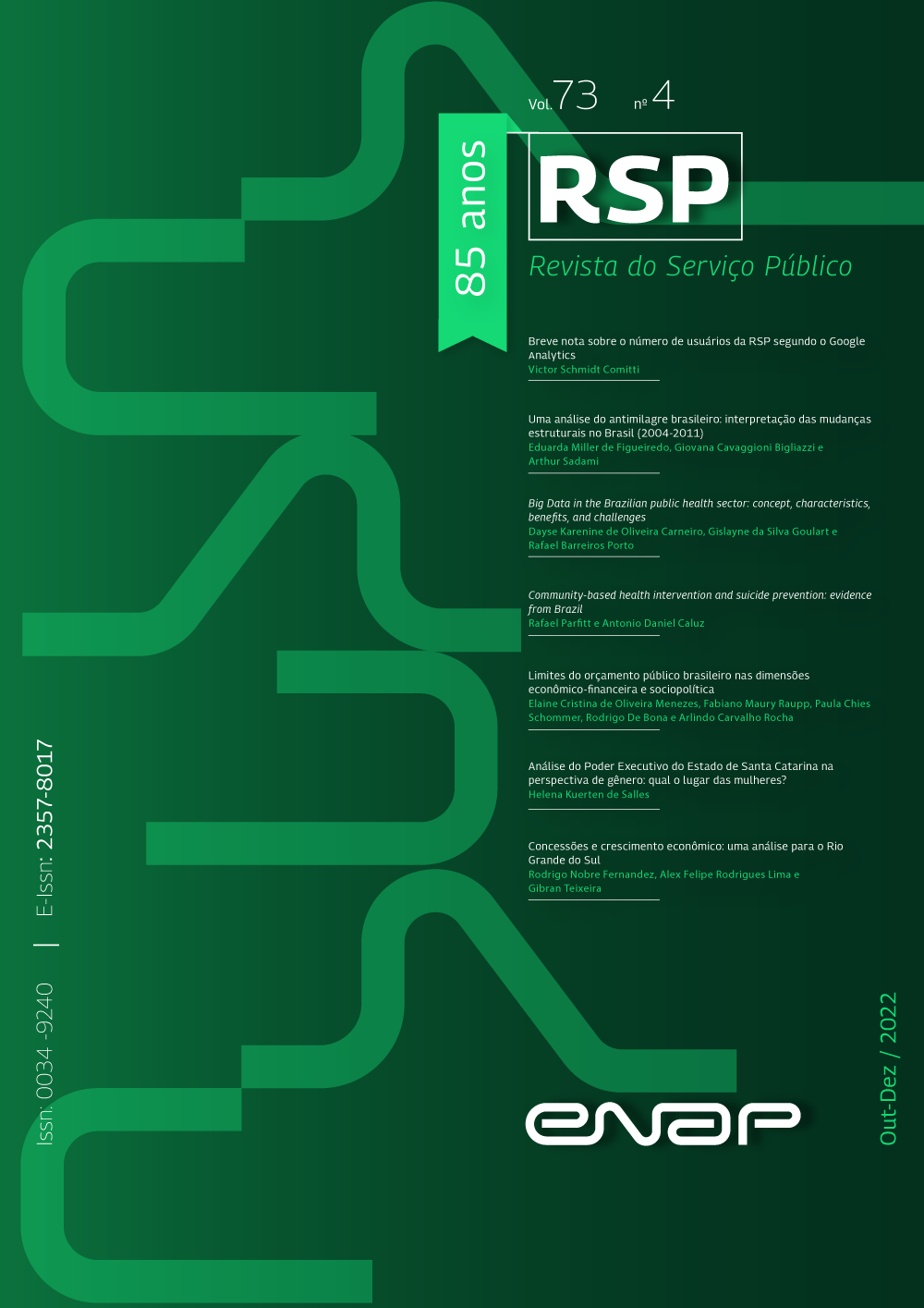An Analysis of the Brazilian Anti-Miracle
Interpreting Structural Changes in Brazil (2004-2011)
Keywords:
Structural change, Sector productivity, Brazil, Economic anti-miracle, Shift-ShareAbstract
The structural changes in Brazil between 2004 and 2011 are analyzed, compared to the Argentine case, and in contrast to the period from 1990 to 2003. First, it is evaluated whether the structural changes within the period frames induced an increase or reduction in growth in the countries. The second exercise uses a Shift-Share to assess changes in Brazil's functional distribution of income. The results suggest that, in the Brazilian case, the commodities boom did not reverse the trend of structural change in the economy favoring services, but (i) it reversed a scenario of slow growth to accelerated growth; (ii) implied a substantial structural boost in the construction sector; and (iii) reduced the flight of labor from industrial sectors. At the same time, the commodities boom led to an attenuation of the Argentine situation (without reversing the downward trend in growth) led by the financial sector, construction, utilities, and mining.
Downloads
References
Baffes, J. e T. Haniotis (2010). Placing the 2006/08 commodity price boom into perspective. World Bank Policy Research Working Paper -(5371), 1–42.
Bercovici, G. (2005). Constituição econômica e desenvolvimento: uma leitura a partir da Constituição de 1988. São Paulo: Malheiros Editores.
Bonelli, R. e S. d. A. Pessôa (2010). Desindustrialização no Brasil: um resumo da evidência. Fundação Getúlio Vargas, Texto para Discussão (n.7) -(7), 1–61.
Bresser-Pereira, Luiz Carlos. Brazil's Quasi-Stagnation and the Growth Cum Foreign Savings
Strategy. International Journal of Political Economy, Abingdon.
Bresser-Pereira, Luiz Carlos. The Dutch disease and its neutralization: a Ricardian approach.
Brazilian Journal of Political Economy, São Paulo, v. 28, n. 1, p. 47-71, 2008.
Canêdo-Pinheiro, M. et al. Por que o Brasil nao Precisa de Política Industrial. Ensaios Econômicos,
São Paulo, n. 644, 2007.
Cano, W. (2012). A desindustrialização no Brasil. Economia e sociedade 21 (spe), 831-851.
Carrasco, Vinicius; Mello, João MP de; Duarte, Isabela. A década perdida: 2003–2012. No. 626.
Texto para discussão, 2014.
Carvalho, L. (2018). Valsa brasileira: do boom ao caos econômico. Editora Todavia SA.
Coutinho, D. R. (2017). Direito, desigualdade e desenvolvimento. São Paulo: Saraiva.
Coutinho, D. R. O Direito Econômico e a Construção Institucional do Desenvolvimento Democrático.
Revista de Estudos Institucionais, Rio de Janeiro, v. 2, n. 1, p. 214-262. 2016.
Fanelli, J. M. Growth, instability and the convertibility crisis in Argentina. CEPAL Review, Santiago,
v. 77, p. 25-43, 2002.
Ferrari, A. e A. M. Cunha (2008). As origens da crise argentina: uma sugestão de interpretação. Economia e Sociedade 17, 47–80.
Furtado, C. Formação de Capital e Desenvolvimento Econômico. Revista Brasileira de Economia, Rio
de Janeiro, v. 6, n. 3, p. 7-45, set. 1952.
Grau, E. R. (2017). A ordem econômica na Constituição de 1988. São Paulo: Malheiros.
Hartmann, D. et al. Why did some countries catch-up, while others got stuck in the middle? Stages of
productive sophistication and smart industrial policies. Structural Change and Economic Dynamics,
Amsterdã, v. 58, p. 1-13, 2021.
Holcombe, R. G. Crony Capitalism: By-Product of Big Government. The Independent Review,
Oakland, v. 17, n. 4, p. 541-559, 2013.
Krueger, A. O. The Political Economy of the Rent-Seeking Society. The American Economic Review,
Nashville, v. 64, n. 3, p. 291-303, 1974.
Lago, M. I. M. y., S. Takagi, M. R. Martin, M. M. Takebe, e M. B. H. Cohen (2004). The IMF and Argentina, 1991-2001. International Monetary Fund.
McMillan, M., D. Rodrik, e Íñigo Verduzco-Gallo (2014). Globalization, structural change, and productivity growth, with an update on Africa. World Development 63, 11–32. Economic Transformation in Africa.
Nassif, A. (2006). Há evidências de desindustrialização no Brasil? Banco Nacional de Desenvolvimento Econômico e Social 28(1(109)), 72–96.
Ocampo, J. A. Industrial Policy, Macroeconomics and Structural Change. CDEP‐CGEG Working Paper
Series, Nova York, n. 81, 2020.
Oreiro, J. L. e C. A. Feijó (2010). Desindustrialização: conceituação, causas, efeitos e o caso brasileiro. Brazilian Journal of Political Economy 30(2), 219–232.
Rowthorn, R. e R. Ramaswamy (1999). Growth, trade, and deindustrialization. IMF Staff papers 46(1), 18–41.
Rugitsky, F. (2016). Milagre, miragem, antimilagre: a economia política dos governos Lula e as raízes da crise atual. Revista Fevereiro 9, 40–50.
Syrquin, M. Patterns of Strucural Change. In: Chenery, H.; Srinivasan, T. N. (Orgs.). Handbook of
Development Economics. Amsterdã: North-Holland, 1988, v. 1.
Tavares, A. R. (2011). Direito Constitucional Econômico. Rio de Janeiro: Forense.
The Economist. Planet Plutocrat. The Economist, Londres, 15 de mar. de 2014.
Timmer, M. P., de Vries, G. J., & de Vries, K. (2015). “Patterns of Structural Change in
Developing Countries.” . In J. Weiss, & M. Tribe (Eds.), Routledge Handbook of Industry and
Development. (pp. 65-83). Routledge.
Tommaso, M. R. et al. Selective industrial policy and ‘sustainable’ structural change. Discussing the
political economy of sectoral priorities in the US. Structural Change and Economic Dynamics, Amsterdã,
v. 54, p. 309-323, 2020.
Wade, R. The paradox of US industrial policy: The developmental state in disguise. In: Salazar-
Xirinachs, J. M.; Nübler, I.; Kozul-Wright, R. Transforming Economies: Making industrial policy work
for growth, jobs and development. Gênova: ILO, 2014.
Downloads
Published
How to Cite
Issue
Section
License
Copyright (c) 2022 Revista do Serviço Público

This work is licensed under a Creative Commons Attribution-NonCommercial-ShareAlike 4.0 International License.
- A RSP adota a licença Creative Commons (CC) do tipo Atribuição – Uso Não-Comercial (BY-NC).
- A licença permite que outros remixem, adaptem e criem obra licenciada, sendo proibido o uso com fins comerciais.
- As novas obras devem fazer referência ao autor nos créditos e não podem ser usadas com fins comerciais, porém não precisam ser licenciadas sob os mesmos termos dessa licença.
- Ao publicar o artigo na RSP, o autor cede e transfere para a ENAP os direitos autorais patrimoniais referentes ao artigo.
- O artigo publicado na RSP não poderá ser divulgado em outro meio sem a devida referência à publicação de origem.
- O autor que tiver o artigo publicado na RSP deverá assinar o Termo de Concessão de Direitos Autorais (em momento oportuno a editoria da Revista entrará em contato com o autor para assinatura do Termo).



